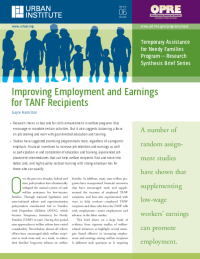Improving Employment and Earnings for TANF Recipients
State approaches to welfare reform vary considerably, but almost all of them encourage adult welfare recipients to work more and, as a result, to reduce their families’ long-term reliance on welfare benefits. This policy brief draws on a large body of evidence from rigorous studies to highlight strategies found most effective in increasing employment and earnings among welfare recipients. Research shows a clear role for skills enhancement in welfare programs that encourage or mandate certain activities. But research also suggests balancing a focus on job-seeking and work with goal-directed education and training.
Studies have suggested promising programmatic tools, regardless of a program’s emphasis: financial incentives to increase job retention and earnings as well as participation in and completion of education and training, experienced job placement intermediaries that can help welfare recipients find and move into better jobs, and high-quality sectoral training with strong employer ties for those who can qualify.
While the strategies highlighted in the brief increased employment and earnings, the increases were rarely what might be considered transformational. This is largely because many approaches have effectively placed people into jobs but have not prevented interruptions in employment or fostered wage progression. Thus, a continued search for new, potentially more effective strategies — and rigorous testing of their feasibility and effectiveness — seems warranted. The brief concludes by suggesting several areas for further exploration:
- Adopting a career pathways framework. Programs using this framework generally offer academic, occupational, and life-skills training that employers value, financial and supportive services, and defined links to employment opportunities, with a goal of moving individuals up career pathways.
- Combining into a single program several features already shown to be effective. Such a program might include financial incentives (to promote work as well as skill building), sector-focused training, and strong connections to employers in specific industry sectors.
- Providing longer-term subsidized employment, combined with sector-focused skills training. Testing would indicate whether lengthened subsidized employment paired with skills training, perhaps also including financial incentives and strong employer connections, could better position individuals to transition into unsubsidized employment and to retain such employment longer. A related approach — apprenticeship programs, in which individuals are trained on the job, practice their skills in real work assignments, and are paid wages that typically increase over time — would benefit from rigorous evaluation, too.
- Providing services to TANF recipients through different institutions. While difficult to mount, evaluations assessing service providers’ effectiveness — TANF agencies, workforce development agencies, community colleges, community-based organizations, for-profit groups, and others — could shed light on an operational issue of key importance to policymakers and program administrators.






